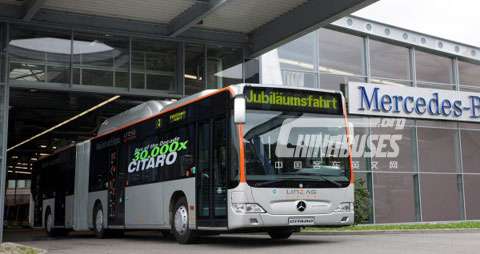After just twelve years in production, the 30,000th Mercedes-Benz Citaro has now been delivered. On 25 August 2010 Michael Göpfarth, head of sales at the Mercedes-Benz Bus and Coach Unit of EvoBus GmbH, handed over the record-breaking vehicle to Walter Rathberger and Erich Haider, managing and executive directors of Linz Linien GmbH, at the Mannheim bus factory.

Mercedes-Benz Citaro 30000th
The majority of the 30,000 Citaros produced to date originate from the Mercedes-Benz bus factory in Mannheim, where the Citaro has been built since 1998. At the end of 2009, a workforce of 3530 was producing Mercedes-Benz urban and rural buses and touring coaches at the production facilities here covering a total of 141,000 square metres of floorspace.
Virtually no two Citaros are alike. This is attributable to the diverse range of variants and to the broad scope for individualisation. At the launch of production in 1988, the Citaro offered a range of urban and rural buses in different lengths and equipment variants. Today, the model range covers 28 different design variants. The spectrum extends from the compact Citaro K measuring 10.5 m in length to the four-axle, 19.54 m long CapaCity articulated large-capacity bus which is also based on the Citaro modular system. With this unique product range, the Citaro covers the entire transportation requirements of bus companies providing regular urban and rural public transport services.
The Citaro G BlueTec Hybrid articulated bus will be produced in a small series in 2010. In parallel with the launch of this bus, the first urban buses with fuel-cell hybrid drives will also go into service. This Citaro FuelCELL hybrid points the way to the zero-emission drive of tomorrow.
The 30,000th Citaro is fitted with an environmentally friendly natural gas engine. The M 447 (h)LAG engine rated at 240 kW complies with the EEV (Enhanced Environmentally friendly Vehicle) emissions standard without a particulate filter. The voluntary EEV emissions standard defines the most stringent European emission levels at present, with limits set below those of the Euro 5 standard.